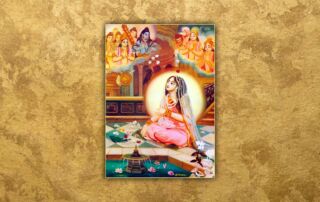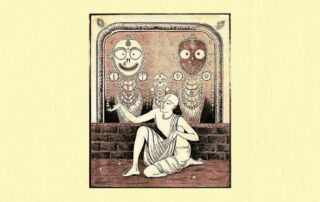Latest Posts
Here you will find all the latest posts on the Bhaktivinoda Institute in the form of Articles, Book Chapters, Songs & Poems etc.
Garbha Stotra Verse Five
In 1870, Śrīla Bhaktivinoda Ṭhākura wrote a commentary to the Garbha Stotra of Śrīmad Bhāgavatam (10.2.26-40) wherein the Demigods pray to Kṛṣṇa within the womb of Devakī. His commentary, the Sambandha Tattva Candrikā (‘That Moon which Reveals the Reality of One’s Relationship with the Lord’) was based upon that of the famous Vaiṣṇava commentator, Śrī Śrīdhara Svāmī.
Garbha Stotra Verse Four
In 1870, Śrīla Bhaktivinoda Ṭhākura wrote a commentary to the Garbha Stotra of Śrīmad Bhāgavatam (10.2.26-40) wherein the Demigods pray to Kṛṣṇa within the womb of Devakī. His commentary, the Sambandha Tattva Candrikā (‘That Moon which Reveals the Reality of One’s Relationship with the Lord’) was based upon that of the famous Vaiṣṇava commentator, Śrī Śrīdhara Svāmī.
Garbha Stotra Verse Three
In 1870, Śrīla Bhaktivinoda Ṭhākura wrote a commentary to the Garbha Stotra of Śrīmad Bhāgavatam (10.2.26-40) wherein the Demigods pray to Kṛṣṇa within the womb of Devakī. His commentary, the Sambandha Tattva Candrikā (‘That Moon which Reveals the Reality of One’s Relationship with the Lord’) was based upon that of the famous Vaiṣṇava commentator, Śrī Śrīdhara Svāmī.
Garbha Stotra Verse Two
In 1870, Śrīla Bhaktivinoda Ṭhākura wrote a commentary to the Garbha Stotra of Śrīmad Bhāgavatam (10.2.26-40) wherein the Demigods pray to Kṛṣṇa within the womb of Devakī. His commentary, the Sambandha Tattva Candrikā (‘That Moon which Reveals the Reality of One’s Relationship with the Lord’) was based upon that of the famous Vaiṣṇava commentator, Śrī Śrīdhara Svāmī.
Bhagavad-gita – Chapter Eighteen
Śrīla Bhaktivinoda Ṭhākura’s first Bengali commentary to the Bhagavad-gītā named ‘Rasika-Rañjana’ (‘That which delights the relishers of rasa’) was written in 1886 and was a combined translation/commentary. This commentary was based upon Śrīla Viśvanātha Cakravartī Ṭhākura’s Sārārtha-varṣiṇī commentary. The Ṭhākura also gave an elaborate introduction to this work describing the connection between the paths of karma, jñāna and bhakti.
Vairāgya (Renunciation)
This article ‘Vairāgya’ by Śrīla Bhaktivinoda Ṭhākura seems to have been published after his disappearance by Śrīla Sarasvatī Ṭhākura in Sajjana Toṣaṇī, Vol.24. Issues 1-2. Bhaktivinoda had previously written a similar article in Vol.11, Issue 6, however, this more extensive article gives greater detail about the topic of renunciation, its characteristics and who is qualified to be a renunciate.
Garbha Stotra Verse One
In 1870, Śrīla Bhaktivinoda Ṭhākura wrote a commentary to the Garbha Stotra of Śrīmad Bhāgavatam (10.2.26-40) wherein the Demigods pray to Kṛṣṇa within the womb of Devakī. His commentary, the Sambandha Tattva Candrikā (‘That Moon which Reveals the Reality of One’s Relationship with the Lord’) was based upon that of the famous Vaiṣṇava commentator, Śrī Śrīdhara Svāmī.
Introduction to Garbha Stotra
In 1870, Śrīla Bhaktivinoda Ṭhākura wrote a commentary to the Garbha Stotra of Śrīmad Bhāgavatam (10.2.26-40) wherein the Demigods pray to Kṛṣṇa within the womb of Devakī. His commentary, the Sambandha Tattva Candrikā (‘That Moon which Reveals the Reality of One’s Relationship with the Lord’) was based upon that of the famous Vaiṣṇava commentator, Śrī Śrīdhara Svāmī.
Jñāna (Knowledge)
Jñāna (‘Knowledge’) was first published in Sajjana Toṣaṇī, Vol.8, Issue 7 in 1897. Śrīla Bhaktivinoda Ṭhākura analyses what is jñāna and then defines the various types of jñāna specifically in relation to the jīva - in particular, he explains svabhāvaja-jñāna (inherent knowledge) and prasādaja-jñāna (knowledge born from mercy).
Bhagavad-gita – Chapter Seventeen
Śrīla Bhaktivinoda Ṭhākura’s first Bengali commentary to the Bhagavad-gītā named ‘Rasika-Rañjana’ (‘That which delights the relishers of rasa’) was written in 1886 and was a combined translation/commentary. This commentary was based upon Śrīla Viśvanātha Cakravartī Ṭhākura’s Sārārtha-varṣiṇī commentary. The Ṭhākura also gave an elaborate introduction to this work describing the connection between the paths of karma, jñāna and bhakti.
Bhagavad-gita – Chapter Sixteen
Śrīla Bhaktivinoda Ṭhākura’s first Bengali commentary to the Bhagavad-gītā named ‘Rasika-Rañjana’ (‘That which delights the relishers of rasa’) was written in 1886 and was a combined translation/commentary. This commentary was based upon Śrīla Viśvanātha Cakravartī Ṭhākura’s Sārārtha-varṣiṇī commentary. The Ṭhākura also gave an elaborate introduction to this work describing the connection between the paths of karma, jñāna and bhakti.
Bhagavad-gita – Chapter Fifteen
Śrīla Bhaktivinoda Ṭhākura’s first Bengali commentary to the Bhagavad-gītā named ‘Rasika-Rañjana’ (‘That which delights the relishers of rasa’) was written in 1886 and was a combined translation/commentary. This commentary was based upon Śrīla Viśvanātha Cakravartī Ṭhākura’s Sārārtha-varṣiṇī commentary. The Ṭhākura also gave an elaborate introduction to this work describing the connection between the paths of karma, jñāna and bhakti.
Bhagavad-gita – Chapter Fourteen
Śrīla Bhaktivinoda Ṭhākura’s first Bengali commentary to the Bhagavad-gītā named ‘Rasika-Rañjana’ (‘That which delights the relishers of rasa’) was written in 1886 and was a combined translation/commentary. This commentary was based upon Śrīla Viśvanātha Cakravartī Ṭhākura’s Sārārtha-varṣiṇī commentary. The Ṭhākura also gave an elaborate introduction to this work describing the connection between the paths of karma, jñāna and bhakti.
Śrī Śīkṣāṣṭakam Verse Eight
Śrīla Bhaktivinoda Ṭhākura’s commentary on Mahāprabhu’s Śikṣāṣṭakam, the Sammodana Bhāṣyam (‘that commentary which gives bliss to the devotees’ ) was written in Sanskrit in 1886. The Ṭhākura gives a detailed explanation of each verse, starting with the mūlā-śloka (verse one), revealing the progressive stages of the sādhaka leading to prema.
Śrī Śīkṣāṣṭakam Verse Seven
Śrīla Bhaktivinoda Ṭhākura’s commentary on Mahāprabhu’s Śikṣāṣṭakam, the Sammodana Bhāṣyam (‘that commentary which gives bliss to the devotees’ ) was written in Sanskrit in 1886. The Ṭhākura gives a detailed explanation of each verse, starting with the mūlā-śloka (verse one), revealing the progressive stages of the sādhaka leading to prema.













